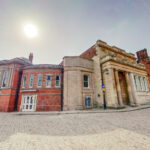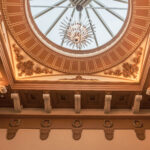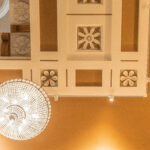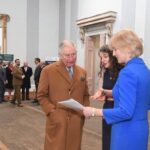Drapers Hall
Homepage » Drapers Hall
Drapers’ Hall
The site on which the Drapers Hall stands was at the core of Coventry’s prosperity in the late Middle Ages.
It was here in the fifteenth century that a Drapery, or cloth market, was established to regulate the sale of cloth that had made the city wealthy.
By the time the Drapery was demolished in 1727, new trades were beginning to supplant cloth, and the Drapers Company, traditionally the most powerful of the trade guilds that had ruled the city for hundreds of years, was as much a gentlemen’s club for Coventry’s elite.
Their first hall, built in 1637, was a ‘dark, gloomy edifice’, the second, erected in 1775, was riddled with dry rot and too small for purpose. And so, in 1830 the company hired Birmingham architect Thomas Rickman to design something a little grander.
With ballroom, card room, tea room and lavish wine cellars beneath, it opened in December 1832 with a ball that attracted the wealthy and powerful from Coventry and surrounding areas.
In the decades that followed, among those to attend social events in the hall was the Crystal Palace creator Sir Joseph Paxton, then MP for Coventry. Among the musicians who performed in the ballroom was the virtuoso pianist and composer Franz Liszt.
During the First World War, the building’s cellars were turned into an air raid shelter for up to a hundred people and in 1939 plans were drawn up for it to take on the same role for up to 200 people. It also became the head-quarters of the Women’s Voluntary Services (WVS) throughout the war.
While the building, somewhat miraculously, had survived the Blitz unscathed, by the early 1950s there were proposals to demolish it as part of a landscaping plan around the new cathedral.
The Drapers Company, who had opposed the plans, sold the hall in 1960 and for the next twenty-five years it was used as a courtroom and as offices for the probation service.
In its life time it has been used by the Coventry Freemasons, Coventry magistrates’ court, a church centre for Holy Trinity church while the Priory was been archaeologically dug and Millennium project was carried out. It was the base for the Coventry Tourist Centre for a few years. In 1990 it was the base for the organising of the 50th Anniversary of the Coventry Blitz. It been used as a rehearsal room for the Coventry Mystery Plays and the Coventry Carnival.
By the 1990s it was empty and while many uses were proposed for it, none came to fruition until the Prince’s Foundation took on the task of breathing new life into it as a music venue and a centre for the city’s schools music service.
The building re-opened on 1st September 2022 following a £5 million restoration project and is now operated by Historic Coventry Trust.
The Conventry Society considers that this building is no longer “at risk”.



